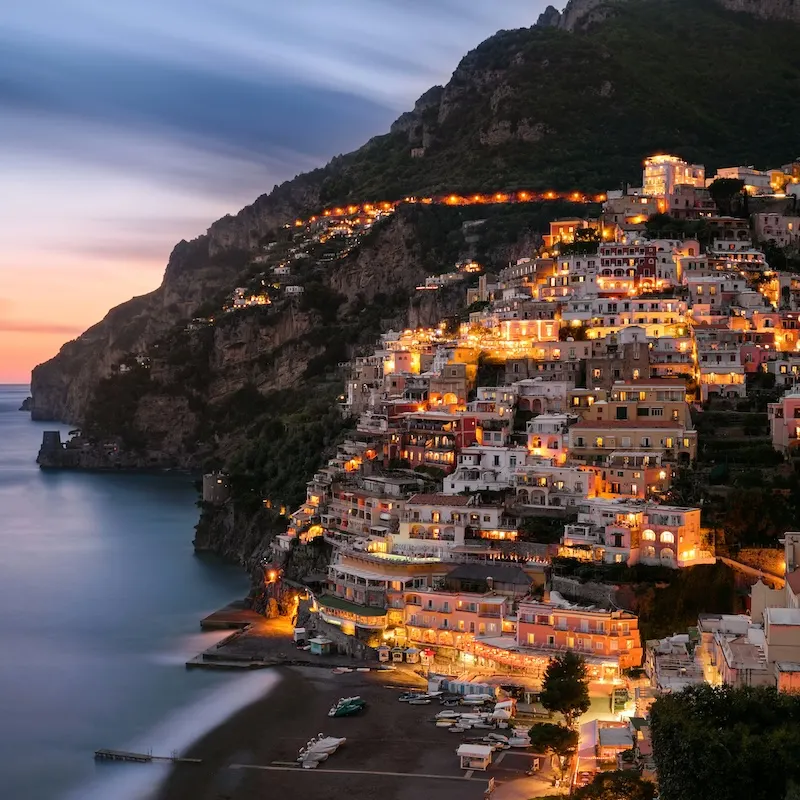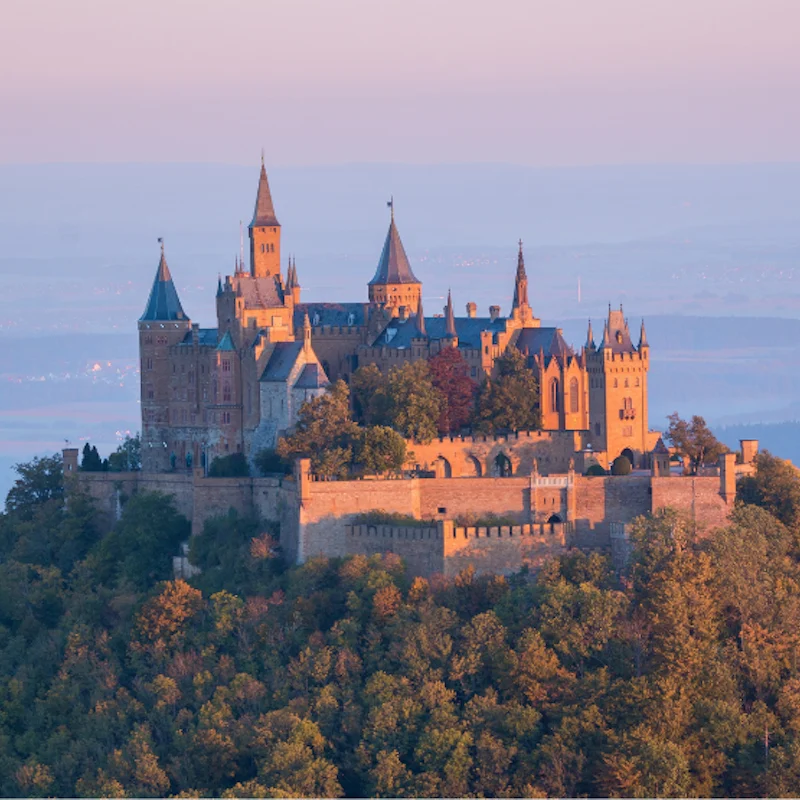Home > Travel Ideas & Inspiration > Fascinating Easter Traditions in Europe
Share this post
Communities worldwide celebrate Easter, but the way they do it, including their rituals and traditions, differs widely.
While Easter is celebrated as a Christian holiday today, many of the traditions associated with it go all of the way back to Pagan times (which pre-date Christianity).
In this article, we're going to take a look at some fascinating Easter traditions in Europe. Whether you're planning a class or lecture, a party, or are just interested in traditions around the world, you'll learn some intriguing Easter facts here!

Czech Easter traditions
The Czech Republic is a country in central Europe with rich Jewish and Christian roots. Their Easter traditions are centered around Christian belief but have evolved over time with Pagan, Jewish, and Christian influence.
Holy Week in the Czech Republic
In Czechia, the festivities begin before Easter proper, during Holy Week. In the Catholic faith, Holy Week leads up to Easter, and in the Czech Republic, there are specific ways that they celebrate.
On Ash Wednesday, it's a cleaning day. On this day, it's in your best interest to have a positive outlook because if you happen to be cranky, it's said you'll be cranky every Wednesday for the rest of the year.
Not a pleasant omen!
Planning a trip to Europe?
Make sure you protect your journey with European travel insurance ✈️
On Green Thursday, you're supposed to eat greens for your health, like cabbage or nettles.
On Good Friday, noisemakers (rattlers and clappers specifically) are attached to wheelbarrows.
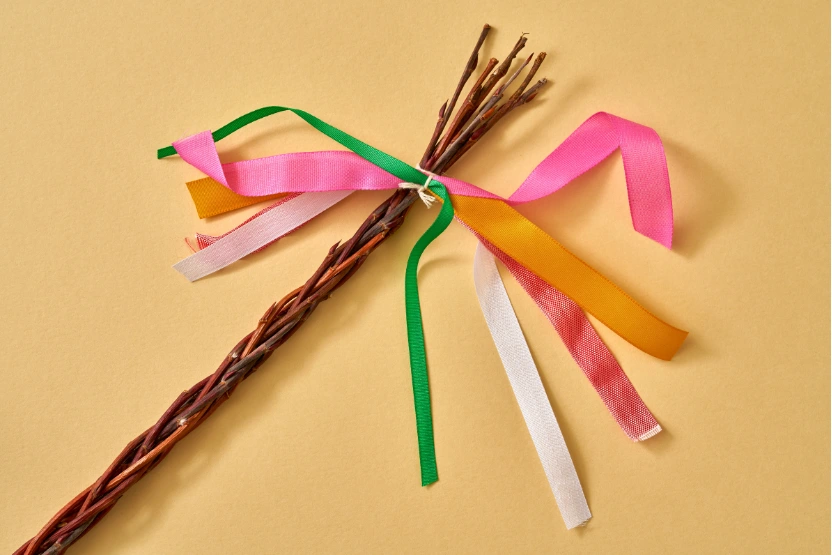
Easter "whipping" in the Czech Republic
"Whipping" women and girls at Easter is a (fading) tradition in the Czech Republic. Using willow branches, boys and men would playfully "whip" women and girls. This tradition was to "help them stay youthful and healthy."
Men and boys braid willow branches together to create uniquely braided whips. While this tradition is fading, there are still cities in the Czech Republic that keep the playful ritual alive.

Czechian Easter egg painting
Like many other places, Czechians paint eggs at Easter time. They paint both boiled eggs and emptied eggs (where a hole is poked through the egg and all of the insides are removed to reveal a hollowed-out, fragile eggshell in one piece).
These "hollowed" eggs can be dyed with natural plant material (such as onion peels or beets), as well as etched or patterned with wax. There's also a special Czechian method of egg decorating called "straw decorating" where dainty pieces of straw are glued to the egg shells to create beautiful, intricate patterns.

French Easter traditions
Like many other European countries, France has deep Christian and Jewish religious roots that make up today's traditions.
House decorating
While chocolate and painting eggs are seen all over the country, there are some interesting traditions that are also region-specific. For instance, in Eastern France (a region known as Alsace), it's tradition to decorate your house before the Easter holiday.
The outside of houses are decorated with branches, painted eggs, flowers, and more. In fact, that's not the only thing outside.
Children build nests out of natural materials (like moss and twigs). This is their Easter basket! Their handmade nests are placed in the yard, where they will wake to find it filled with dyed eggs and chocolate.
The gift of the egg
In old tradition, the French gifted each other painted eggs at Easter time. This is likely because eggs were off-limits during Lent (a 40-day "fasting" period that leads up to Easter).
Back in Medieval times, there would be a plethora of eggs by Easter, making them the perfect gift to celebrate the end of Lent in France.
Other Easter gifts
In France, Easter is a gift-giving holiday. It's not uncommon to give or receive a small gift, especially something like chocolate.
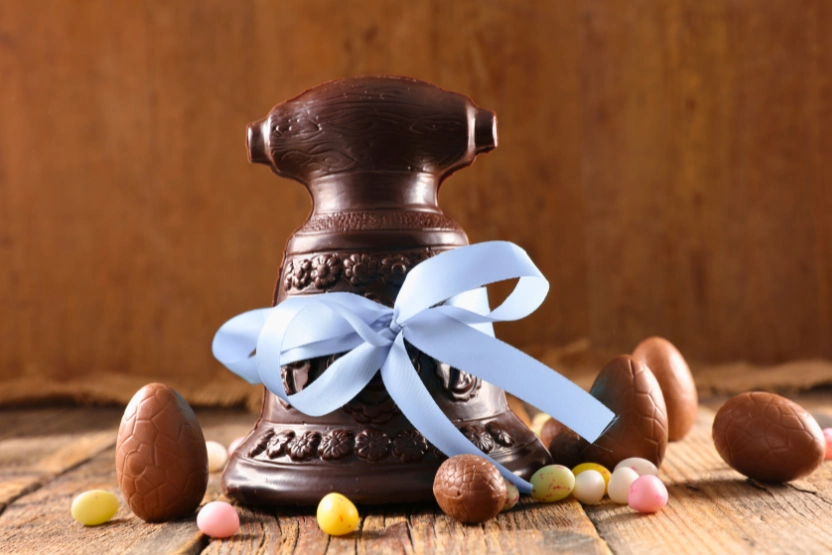
The Easter Bells
While today the Easter Bunny is part of French Easter traditions, it stems from the Easter Bells.
Easter Bunnies didn't bring eggs, chocolate, and gifts for children in France. Instead, the Easter Bells did. On Easter, bells would fly back from Rome and leave gifts (eggs) for children.
Fish-shaped chocolate
In the Roman era, fish icons were a signal of the persecuted Christians. In fact, the Christian faith still uses the fish as a symbol today.
If you ever spend Easter in France, you may see chocolate shops selling intricate fish and seashell-shaped chocolates to celebrate the holiday.

German Easter traditions
With strong Christian roots, Germany celebrates Easter in several ways with a lead-up through Lent and Holy Week.
With delicious food, fun events, and the tradition of the Easter Bunny, this holiday in Germany is a special time. In fact, the Easter Bunny originates from Germany!
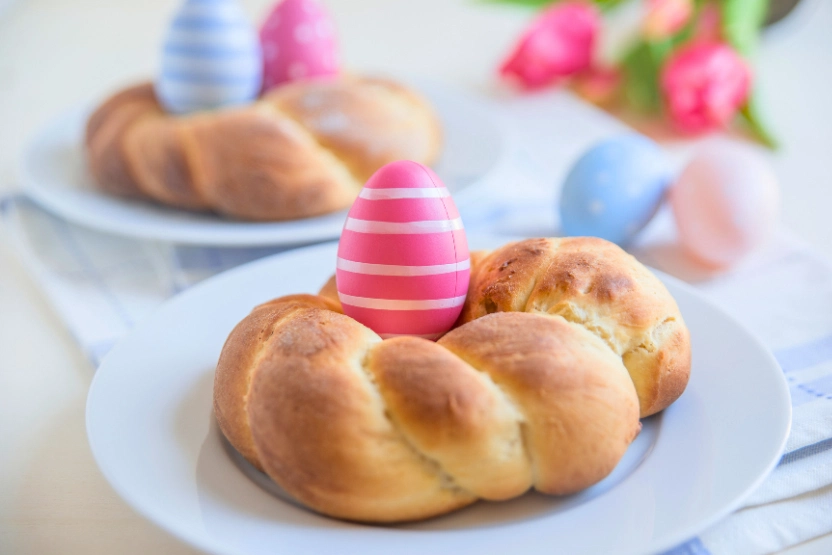
German Easter bread
Easter bread (or Osterbrot in German) is a tradition all around the country, though specific types of Easter bread can depend on the region you're in.
The bread can be braided, twisted, in a circular shape, etc. It may be sweet, less sweet, have raisins or almonds, and more. Regardless of which region you're in and what their traditional bread is, you'll find Easter breads all around Germany around this time.
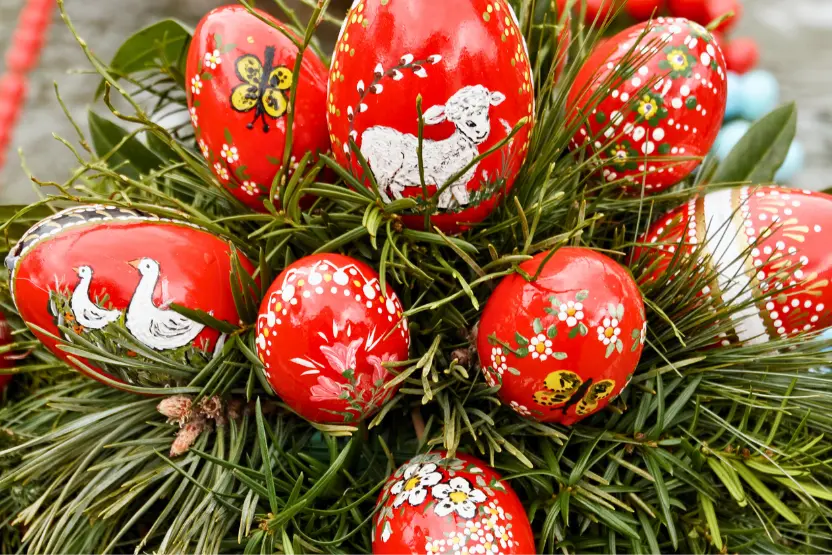
German Easter eggs
In Germany, Easter eggs can be decorated in several ways on both boiled eggs and hollowed-out ones.
Decorating methods vary greatly from intricate hand painting (as seen in the photo above) to etching, patterned dye, plain dye, and more.
Easter eggs are often hung on "Easter trees", small trees that are either indoors or outdoors to celebrate the holiday.

Easter and the outdoors
German culture prizes nature and the great outdoors. During Easter, it's no different!
In some parts of Germany, you may see Easter Bonfires. These bonfires usually take place the night before Easter Sunday and can involve cookouts and sometimes even carnival games and rides.
Easter walks are also popular in German culture, where families go on a nice walk to celebrate the holiday.
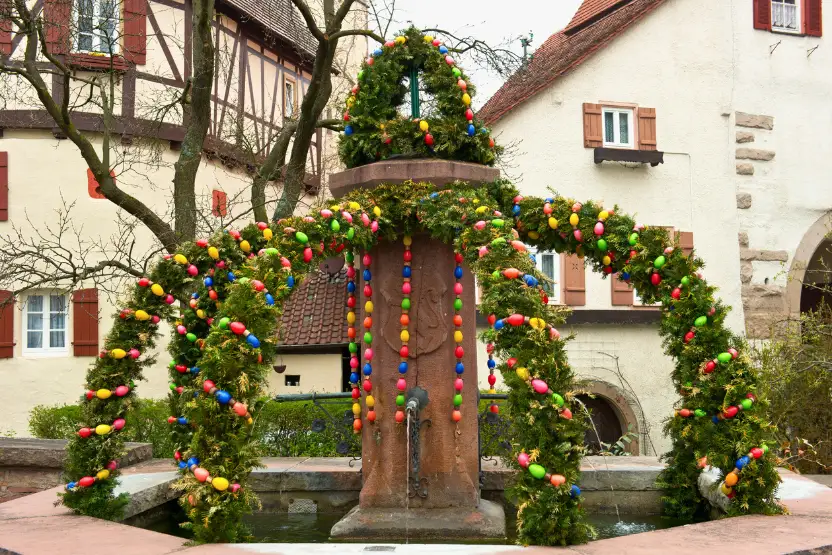
German Easter fountains
While newer in the grand scheme of German traditions, decorating fountains on Easter dates back to the early 1900s.
Outdoor fountains and wells are often decorated with greenery and colorful eggs, typically in an ornate "crown" shape.
If you're traveling to Germany leading up to Easter, you may very well see these elaborate works of art!

Greek Easter traditions
Easter is celebrated in Greece with traditions and rituals happening during Holy Week up to Easter Sunday.
Holy Week in Greece
During Holy Week, church chandeliers are often draped with purple and black ribbons. Different days during Holy Week have different traditions associated with them.
On Maundy Thursday of Holy Week, a traditional Easter brioche called tsoureki is made (pictured below). Alongside this Easter bread, it's also traditional to make cookies as well as dye eggs bright red.
On Good Friday, young women and girls decorate the Epitaphios. An Epitaphios is a religious icon used in the Catholic church, and during Easter, it is decorated with flowers.

On Holy Saturday (the last day of Holy Week before Easter itself), quite a few different events take place. Parades go through town, and locals drop clay pots out of their windows (as pictured above).
There is a Midnight Mass with a traditional dinner after the service. This mass has fireworks, drums, and Church bells to celebrate Easter Sunday. After Midnight Mass, it's tradition to go home, where each person cracks a red egg.
Throughout the evening, you will see lit white candles all over town.
Greek Easter lamb
In Greece, it's traditional to eat Lamb on Easter Sunday. Depending on which part of the country you're in, the lamb is prepared differently. In fact, goat may be the preferred dish as well, depending on the region or city.
You may see lamb skewered and cooked over charcoal or baked in the oven.

Italian Easter traditions
Italy has a long Catholic history and some of the most elaborate Easter celebrations and rituals.
Traditions vary from region to region, making Easter in Italy a rich experience no matter where you go.
Egg games
The egg is at the center of Italian Easter traditions with many different rituals and games surrounding it. Different regions have different traditions when it comes to exactly how the egg is incorporated into the local events.
In the Marche region, for example, Italians challenge each other to egg-breaking contests.
In the south, youths go to farmhouses around the town, singing songs. Then, on Monday, a large omelet is prepared that all of the participants share.
In the Northeast, boys ask girls for eggs. Girls can say yes or no, and whoever gets 12 eggs is said to be married in a year.
The Devil's Dance
In Sicily, the "Devil's Dance" is held on Easter morning. People dress in red (with masks) to represent the devil, and then in yellow (also masked) to represent death.
During the event, the costumed devils and death (playfully) harass viewers until they are chased away by other participants dressed as angels.
Easter parades
Throughout Italy, you will see parades with different costumes and decorations (depending on the location and region).
You may see ornately decorated floats, costumed performers, and even fireworks and explosions!
Decorated eggs
Like many other European cultures, Italy has a long history of decorating eggs for Easter. These eggs can be painted, but they can also be "fake" eggs made of materials like ceramic or glass in Venice.
Nowadays, chocolate eggs are also popular in Italy.

Polish Easter traditions
In Poland, Easter has its own fascinating traditions. While it's a Christian holiday, many of the rituals in Poland still have many Pagan roots.
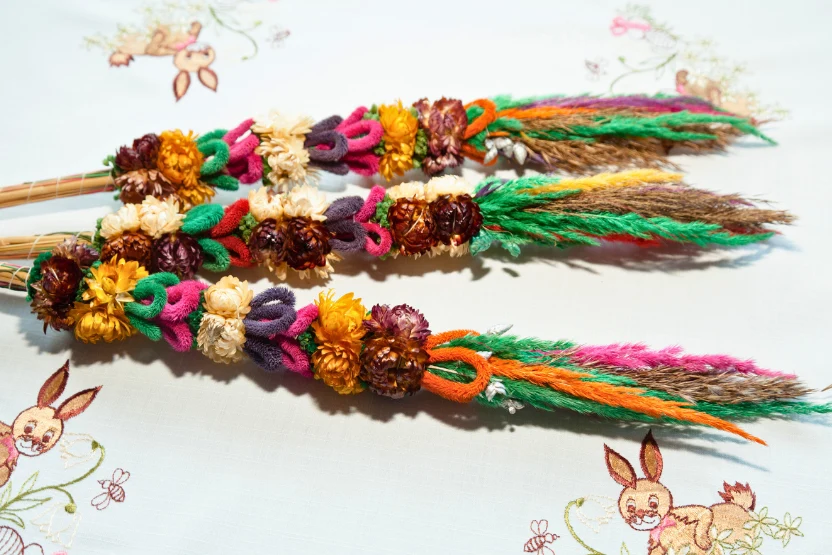
Decorated palms
Decorated "palms" are often seen at the local churches or in parades. Palm trees aren't exactly common in Poland, so pussy willows are usually used instead. However, these "palms" are heavily decorated with greenery and flowers and can be multiple feet tall.
Polish Easter eggs
The day before Easter Sunday, hard-boiled eggs are decorated. These eggs are often dyed via natural methods (like onion peels), but artificial dyes are also used nowadays.
They're also commonly intricately painted or designed.
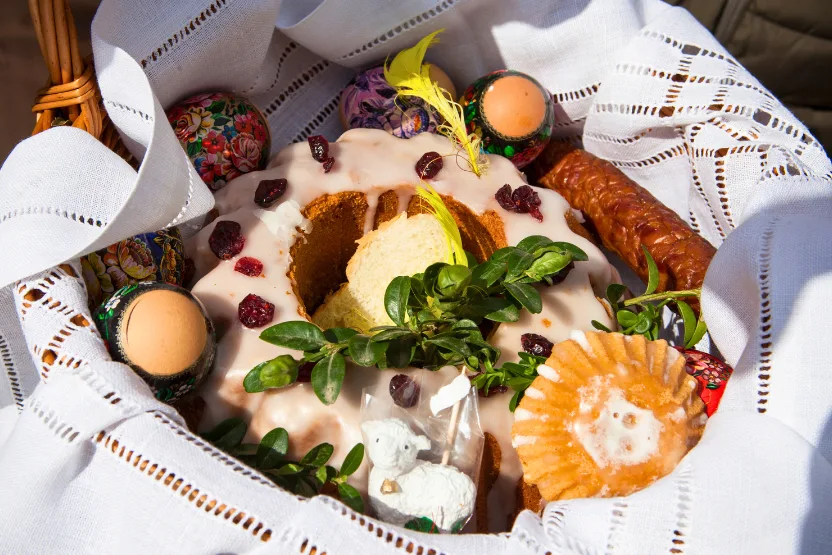
Polish Easter baskets
Easter baskets are an important part of Polish celebrations.
In a simple basket, several types of Polish food are placed on top of bright green sprigs. The baskets can contain hard-boiled eggs, slices of fresh bread, sausage or ham, Easter cake (called mazurek, photographed above), and even salt and pepper. It's also customary to put either a chocolate or plastic lamb in the basket, then take the entire thing to the church to be blessed.
Easter breakfast
Eating breakfast with your family is essential in Polish tradition. Typically, cold dishes are served, especially meats. Classic Easter cake is also served.
Wet Monday
The Monday after Easter is known as "Wet Monday" since it's traditional for boys to dump water over girls.
Dating back to the 14th century (or perhaps even earlier), this tradition symbolizes rebirth and renewal.
After tossing water over the girls, the boys then "whip" them with willow branches.
Nowadays, the tradition has evolved, and anyone can throw water on anyone else on Wet Monday. Don't forget your umbrella ?

Slovakian Easter traditions
In Slovakia, Easter is all about rebirth with its rituals dating back to Pagan times.
Like other European countries, specific rituals and traditions depend heavily on the region you're in.
Slovakian Easter eggs
Slovakians have been decorating eggs for centuries and have some of the most detailed and ornate Easter eggs imaginable.
Hollowed eggs can be decorated with glass, metal, wood, dye, wax, and more.
These eggs can be gifted to loved ones and hung on trees, inside or outside your home.

The Goddess of Winter and Death
Easter time also means it's time for an event called the Procession of Morena. Morena, the ancient Slovakian Goddess of Winter and Death, is carried through town (as an effigy dressed in women's clothes). Then, she is thrown into the water or burned, depending on where you are. This event symbolizes the coming of Spring.
Slovakian Easter baskets
Like the Polish, Slovakians create Easter baskets filled with food and then have their baskets blessed at the local church.
Slovakian Easter baskets usually contain bread, hard-boiled eggs, meat, cheese, and more. They also often have beetroot and horseradish.
Whipping and water
Like in Czechia and Poland, the Monday after Easter traditionally involved men and boys "whipping" women and girls with willow branches and ribbons. It also involved pouring water on them or spraying them with perfume.
On Monday, the men "attack" the women. However, on Tuesday, the women and girls do the same thing back to the men and boys.

Spain Easter traditions
Spain has deep Catholic roots and its Easter traditions reflect that through incredible festivities and rituals.
Like many other European countries, Holy Week is celebrated leading up to Easter.
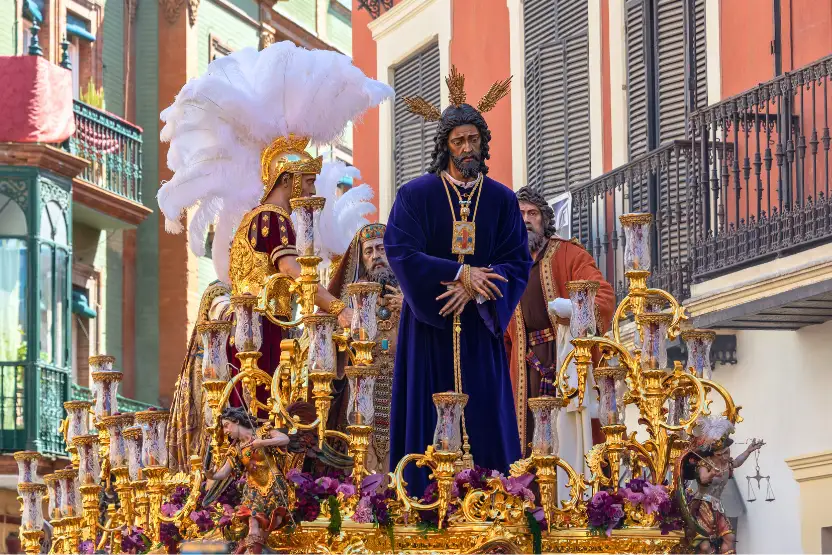
Spanish Easter parades
Beginning the Sunday before Easter (Palm Sunday), parades begin to happen all over Spain.
Parades and processions are filled with locals in costumes, carrying beautiful religious arrangements. These are called Pasos (pictured above). Other religious symbols may be carried too, like Jesus on the cross.
Spanish Easter eggs
Hard-boiled eggs are used as decorations and are also eaten. They're also sometimes handed out during parades.
Unlike in some countries, they aren't used as decoratively around the country, though you still may see them here and there.
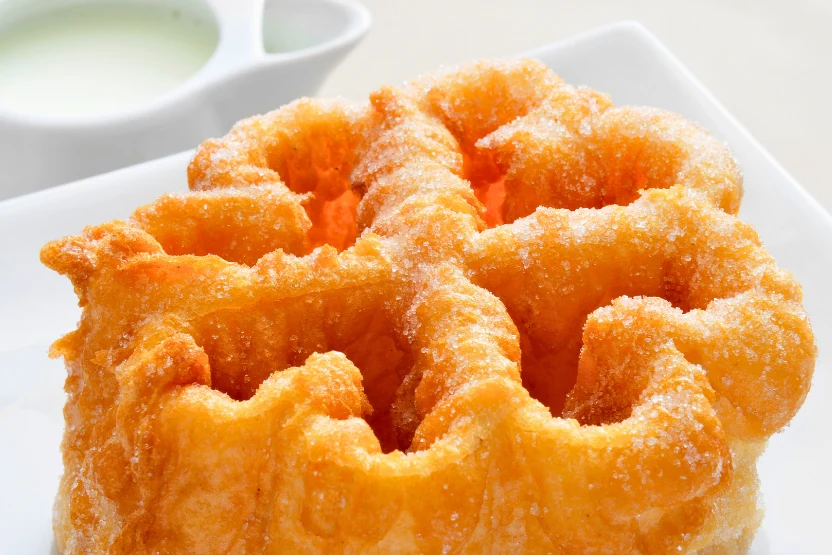
Spanish Easter food
Enjoying food with your family is a must on Easter Sunday in Spain. There are several traditional foods you can expect to find in a Spanish Easter spread.
You may find:
- Small donuts (called Bueñelos).
- Garlic soup.
- Chocolate Easter eggs.
- Torrijas (similar to French toast).
- Flores Fritas de Semana Santa (a crunchy, fried dough pastry).
- Ring-shaped bread with an egg in the center (called Mona de Pascua).

Swedish Easter traditions
Sweden has many Easter traditions, starting in Holy Week and then leading up to the holiday itself.
The Easter traditions here are a unique combination of Christian tradition, Old Norse, and folk rituals, making it a truly original experience.
The Swedish Easter Witch
In Swedish folklore, on Good Friday the Easter Witch flies on a broom to a make-believe island. Once there, she "mingles with the Devil." Then, she returns to Sweden on Easter Sunday.
Children dressed like the Easter Witch go door to door where they trade drawings and letters for candy. The event is similar to Halloween Trick-or-Treating in the States.
Swedish Easter candy
Candy is huge in Sweden on Easter!
There are several types of candy associated with Easter in Sweden. Some of these candies include strawberry laces, chocolate, lemon toffee, jelly eggs, marzipan, and more.
Easter bonfires
Like in Germany, Easter bonfires are traditional in Sweden. These bonfires usually take place the day before Easter and are meant to fend off evil.
Easter trees
Similar to the idea of a Christmas tree, Easter trees can be seen all over Sweden during the holiday. These trees usually consist of small branches and are decorated with anything from colorful feathers and flowers to small yellow hens made from yarn.
Swedish Easter egg painting
The Swedes also paint Easter eggs. Their eggs, like many other traditions in Europe, are dyed from natural plants. They even sometimes loosely wrap the boiled eggs in tinfoil before dying them, which gives a unique marbled effect on the overall result.
The Easter smorgasbord
Easter is a holiday with a lot of food in Sweden!
Some of the foods that can be found at a Swedish Easter event are:
- Easter lamb or even ham.
- Charcuterie.
- Quiche (called Västerbottenpaj).
- Potatoes au gratin with onions and anchovies.
- Pickled herring.
- Egg salad with anchovies.
- Seasonal Easter beer and libations.
- Candy!
Happy Easter, everyone ?
Related posts
Upcoming travels ? Get Insured !
Find the right insurance for your trip by using our powerful comparison tool!
Sarah Pardi - November 21, 2025
Sarah Pardi - November 20, 2025
Sarah Pardi - November 14, 2025
Sarah Pardi - November 13, 2025


